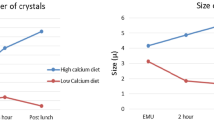Summary
Excretion and concentration of glycose aminoglycans were measured in 19 patients with frequent relapses of calcium-oxalate lithiasis, prior to and two weeks after onset of Diclofenac-Na therapy. In most patients, markedly anhanced glycose aminoglycan concentration and excretion could be demonstrated. Elevation of the high-molecular inhibitor potential in the urine results in reduced risk of calcium-oxalate lithogenesis, which may explain the therapeutic successe of nonsteroidal anti-inflammatory drugs in the treatment of therapy resistent calcium-oxalate lithiasis.
Similar content being viewed by others
References
Annefeld M (1984) Die Bedeutung der Chondrozyten für die Erhaltung der Integrität des Gelenkknorpels. Aktuel Rheumatol [Suppl] 1:37
Börner R-H, Brundig P, Mäurer F, Berg W, Baumann W (1983) Über den Einfluß proteolytischer Fermente, Elektrolyte und andere Faktoren auf die Kristallisation von Kalzium-Oxalat im Urin. Z Urol Nephrol 76:327
Brundig P (1987) Das stressinduzierte Bildungsrisiko der Kalzium-Oxalat-Harnsteine. Doctoral thesis, Friedrich-Schiller-University, Jena, p 69
Brundig P, Börner R-H (1987) Clinical results in the treatment of therapy-resistant calcium-stone formers with non-steroidal anti-inflammatory drugs. Eur Urol 13:46
Brundig P, Pirlich W, Börner R-H, Wittig E (1986) Diclofenac-Na — eine alternative Behandlungsmöglichkeit beim therapiere-sistenten Kalzium-Oxalat-Steinleiden? Urologe [A] 25:204
Buck AC, Cote JC, Sampson WF (1983) The influence of renal prostaglandins on urinary calcium excretion in idiopathic urolithiasis. J Urol 129:421
Buck AC, Davies CJ, Brown R, Sabur RY, Murray K (1985) The influence of flurbiprofen on calcium excretion and vitamin D3 in recurrent calcium lithiasis — a double-blind study. In: Urolithiasis and related clinical research. Plenum Press, New York, p 573
Cavalli-Sforza L (1969) Biometrie — Grundzüge biologischmedizinischer Statistik. Fischer, Jena, p 72
Colette C, Aquiore L, Mommier S, Mimrau A (1982) The influence of indometacin and possible role of prostaglandins on calcium renal excretion. Renal Physiol 5:68
Endo M, Namiki O, Yosizawa Z (1980) Heterogenity of human urinary glycosaminoglycans. J Exp Med 131:167
Greenwood SL, Green R, Blacklock NJ (1985) The effect of indomethacin and flurbiprofen on calcium excretion and glomerular filtration rates in the anesthetized rat. In: Urolithiasis and related clinical research, Plenum Press, New York, p 213
Hartl PW (1984) Nichtsteroidale Antirheumatike. Aktuelle Aspekte der medikamentösen Therapie rheumatischer Erkrankungen. Therapiewoche 34:1775
Hesse A, Hartmann U, Schneider H-J, Horn G (1975) Zur Bedeutung der Mucopolysaccharidausscheidung beim Harnsteinleiden. Z Urol Nephrol 68:401
Houser M, Zimmermann B, Davidmann M (1984) Idiopathic hypercalciuria associated with hyperreninemia and high urinary prostaglandin E. Kidney Int 26:176
Kalbheu DA (1982) Chondroprotektive and antiarthrotische Eigenschaften von Glykosam/inglykanpolysulfat (GAGPS) bei der tierexperimentellen Gonarthrose. Rheumaforsch 41:219
Keusch G, Neftel KA (1988) Häufige Probleme der nichtsteroidalen Antirheumatika (NSA) im Alter. Schweiz Med Wochenschr 118:438
Keutel HJ (1965) Localization of uromucoid in human kidney and in sections of human kidney stones with the fluorescent antibody technic. J Histochem Cytochem 13:155
Kleesick K, Olschowski G, Schäfer N, Greiling H (1981) Einfluß antiphlogistisch and antidegenerativ wirksamer Substanzen auf die Hyaluronat-und Proteogly/canbiosynthese. Verh Dtsch Ges Rheumatol 7:527
Kruze D, Fehr K, Böh A (1976) Effect of antirheumatic drugs on cathepsin B1 from solvine spleen. Z Rheumatol 35:95
Kuschinsky G (1981) Kurzes Lehrbuch der Pharmakologie und Toxikologie. Thieme, Stuttgart New York, p 303
Miehle W (1985) Medikamentöse Therapie rheumatischer Krankheiten. Thieme, Stuttgart New York, p 12
Polmoski MJ, Brandt KD (1983) Relationship between matric proteoglycan content and the effects of salicylate and indomethazin on articular cartilage. Arthritis Rheumatism 26:528
Rao PH, Blacklock NJ (1984) Treatment of indiopathic hypercalciuria by prostaglandin synthetase inhibitors. Urol Res 12:98
Reinicke C (1982) Diclofenac-Natrium (Voltaren®) — ein erprobtes neues nichtsteroidales Antirheumatikum. Klinische pharmakologische Grundlage für eine rationale Therapie. Medikamentum 23:226
Reinicke C (1985) Zur klinischen Pharmakologie der nichtsteroidalen Antiphlogistika. Teil 1: Pharmakokinetik. Z Ärztl Fortbild 79:321
Robertson WG, Scurr DS, Sergeant DW (1985) Ionic and macromolecular modifiers of crystallisation of calcium salts in urin. Fortschr Urol Nephrol 23:1
Sallman A (1979) The chemistry of dixlofenac sodium. Rheumatol Rehabil [Suppl] 2:4
Schäfer RM, Hesse A, Wurzel H, Busch B, Vahlensieck W (1988) Zur Bedeutung der GAG-Ausscheidung im 24h-Harn von Calciumoxalatsteinpatienten und Gesunden. IX Jenaer Harnsteinsymposium. Wiss Beitr der FSU Jena, p 49
Schlichter A, Brundig P (1988) Retrospektive Auswertung unserer Harnsteindispensaire — Nebeneffekte eine antirheumatischen Therapie. IX Jenaer Harnsteinsymposium. Wiss Beitr der FSU Jena, p 149
Schulz E, Börner R-H, Brundig P, Mäurer F (in press) The influence of different factors on the formation of calcium-oxalate stones. Part II. Discriminant analytical pomputations of morphological parameters of pelvi-calyceal systems and calciumoxalate stone patients. Eur Urol
Teller WM (1962) Urinary excretion of acids MPS in normal children and patients gargolism. J Lab Clin Med 59:95
Author information
Authors and Affiliations
Rights and permissions
About this article
Cite this article
Brundig, P., Börner, R.H., Haerting, R. et al. Glycose aminoglycane excretion and concentration in the urine of patients with frequently recurrent calcium-oxalate lithiasis prior to and following Diclofenac-Na therapy. Urol Res 18, 21–24 (1990). https://doi.org/10.1007/BF00294576
Accepted:
Issue Date:
DOI: https://doi.org/10.1007/BF00294576




